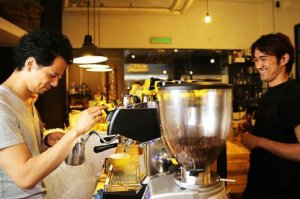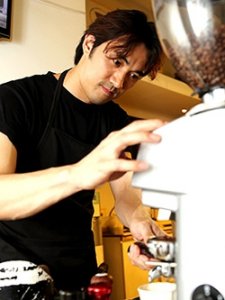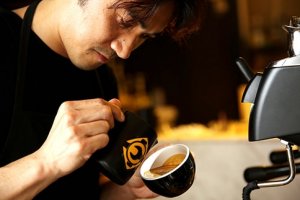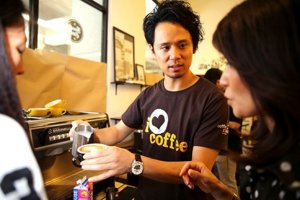 Travelling baristas Junichi Yamaguchi (left) and Masa Aoki (right) sharing a laugh. — Picture by Choo Choy MayKUALA LUMPUR, June 27 — Honestly, I’m as guilty as many others of snapping a carefully-framed shot of my coffee for Instagram before drinking it. Hands up those of you who have done the same: be truthful now, there’s no shame in admitting you are addicted to latte art.
Travelling baristas Junichi Yamaguchi (left) and Masa Aoki (right) sharing a laugh. — Picture by Choo Choy MayKUALA LUMPUR, June 27 — Honestly, I’m as guilty as many others of snapping a carefully-framed shot of my coffee for Instagram before drinking it. Hands up those of you who have done the same: be truthful now, there’s no shame in admitting you are addicted to latte art.
In fact, a cup of well-crafted latte art is akin to tasting the barista’s creativity with your eyes as well as your lips, feasting first on the vision before breaking the spell by your tentative first sip.
It’s easy enough to understand why latte art is such a craze among coffee drinkers; the question is, are baristas who fancy themselves milk-foam Picassos as enamoured of this trend?
 Barista trainer Masa Aoki grinding coffee beans. — Picture by Choo Choy MayThe brotherhood of the travelling baristas
Barista trainer Masa Aoki grinding coffee beans. — Picture by Choo Choy MayThe brotherhood of the travelling baristas
One of my favourite latte art memories is of Coffee Stain barista trainer Masa Aoki drawing Spongebob Squarepants on the surface of a cappuccino for a customer (and latte art fan). It was quite remarkable though the process was necessarily painstaking.
Aoki admits he prefers free-pouring latte art (where steamed milk is poured directly onto an espresso shot to form a pattern) versus etching (a tool such as a toothpick is used to scratch a design on the coffee’s surface).
 He says: “Free-pouring feels more natural and immediate. Of course, etching takes a lot of skill too, but as it takes longer, the coffee may get cold.”
He says: “Free-pouring feels more natural and immediate. Of course, etching takes a lot of skill too, but as it takes longer, the coffee may get cold.”
This is often put forth as a criticism of latte art fanaticism as baristas, especially new ones, place more emphasis on a beautifully-formed latte art over more the coffee’s taste and temperature.
Thirtysomething “travelling barista” Aoki is familiar with this problem as he has been globetrotting as a barista and coffee consultant for 10 years now. He has trained baristas in Malaysia since 2011 and recently served as a judge at this year’s Malaysia Barista Championship.
“It all started when I moved to Italy to play soccer. One of my best friends was an Italian barista and he would make me espresso at his café every day. Soon I fell in love with coffee.”
 Barista trainer Masa Aoki demonstrates how free pour latte art is done. — Picture by Choo Choy MayAoki would later return to Japan and pursue his new passion by working with three-time Japan Barista Champion Chihiro Yokyoyama. “It was from him that I learned more about espresso and latte art, ” he says.
Barista trainer Masa Aoki demonstrates how free pour latte art is done. — Picture by Choo Choy MayAoki would later return to Japan and pursue his new passion by working with three-time Japan Barista Champion Chihiro Yokyoyama. “It was from him that I learned more about espresso and latte art, ” he says.
“For instance, did you know that different latte art designs can also taste different? A heart design may require thicker milk foam than a leaf design, which has a silkier mouthfeel.”
With the help of a Korean barista judge, Aoki continued his education — she introduced him to World Barista Championship head judge and coffee trainer Justin Metcalf.
 Aoki recounts his journey: “I worked at Metcalf’s café in Melbourne and learned about roasting. When I went back to Tokyo, I opened my own café called Bruno in Roppongi. And now I’m in Malaysia.”
Aoki recounts his journey: “I worked at Metcalf’s café in Melbourne and learned about roasting. When I went back to Tokyo, I opened my own café called Bruno in Roppongi. And now I’m in Malaysia.”
Where latte art is concerned, Aoki has a Zen-like approach: “If customers order a designed cappuccino and the latte art makes them happy, then I’m happy too. It’s as simple as that.”
Source: www.themalaymailonline.com











